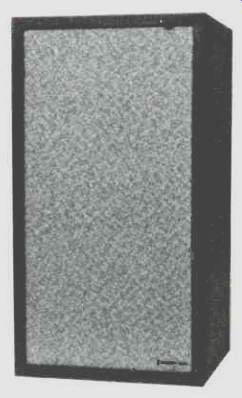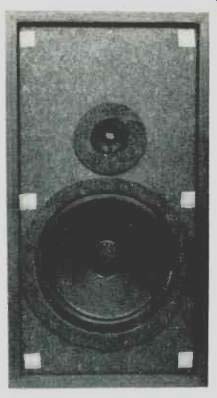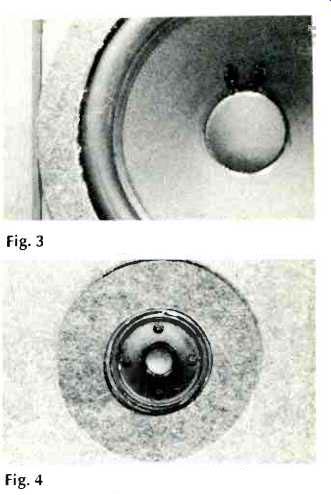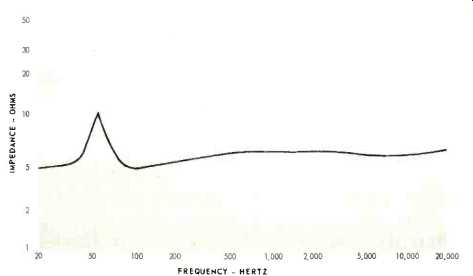MANUFACTURER'S SPECIFICATIONS:
Speaker Complement: One 11" high compliance woofer, one 2 1/2" closed back, direct-radiator cone tweeter.
Impedance: 8 ohms.
Power Handling Capacity: 60 watts music power.
Recommended Amplifier Power: 30 watts.
Crossover Network: L-C type, 6 dB per octave.
Crossover Frequency: 1 kHz.
Enclosure: 1.324 cubic feet, acoustic suspension principle.
Finish: Oiled walnut, four sides.
Dimensions: 23 ¼ in. x 12 3/4 in. x 11 7/8 in. deep.
Suggested Retail Price: $99.95.

Fig.1
University's new "Project M" two-way loudspeaker system disproves an old speaker "cliche." Generally, it has been maintained that small, bookshelf speaker enclosure designs embodying acoustic suspension principles are low-efficiency devices, requiring a great deal of amplifier input power to produce high levels of sound. This is just not true in the case of the "Project M" system. A mere ten watts of amplifier power will produce a 102-dB output at a distance of four feet, which is about the equivalent of a loud symphony orchestra, listened to at a distance of about 15 feet. On the other hand, the unique design and construction of the eleven-inch woofer used in this system is such that it can handle power inputs far in excess of that modest amount-up to 60 watts of music power without the slightest audible or measured indication of "break-up." If these claims seem a bit far fetched, a look at some of the new concepts embodied in this relatively low-priced system may help to explain how these goals were achieved.
Figure 1 shows the complete system, with neutral beige grille cloth frame in place. The grille cloth is mounted on an easily removable Masonite frame which is retained in place by bits of "zipper" type fabric which engage similar squares of fabric stapled to the main body of the enclosure. Removal of the front grille frame discloses the speaker elements themselves, which are front mounted, as shown in Fig. 2. The apparent secret of the excellent distortion free performance of the eleven inch woofer is the four-layer, large diameter voice coil and a soft, rubber surround suspension, to which University has given the name Unirol. This combination of design innovations, along with a suitably heavy magnet structure and four-layer voice coil winding results in the unusually high order of transducer efficiency noted earlier, as well as the capability of the cone to make excursions of over 14 inch while maintaining extreme linearity all the way down to about 40 Hz. At somewhat lower power input levels (up to about 10 watts) we were able to measure fundamentals containing little apparent "doubling" as low as 30 Hz! A close up view of the "rubberized roll" suspension employed in the woofer is shown in Fig. 3, while a detail view of the tweeter front is shown in Fig. 4.

Fig. 2-Grille cloth panel removed

Fig. 3-Showing the "Unirol" suspension; Fig. 4-Close-up of closed-back
tweeter

Fig. 5--Impedance characteristics of "Project M" system.
This tweeter, according to the manufacturer, has a specially designed cone that has a smoothly and progressively decreasing radiating area as the frequency increases. This is said to result in the tweeter's operating as a virtual point source of sound at all frequencies within its range, giving extremely broad dispersion and no "beaming" effect at any particular frequency. In addition to having a fully closed back, the inside surface of this tweeter is lined with fiberglass for additional mechanical and acoustical damping. While the cone is only 2.5 inch in diameter, it is mounted into a four-inch frame in such a way as to isolate it completely from the woofer.
Crossover frequency for this system was chosen at 1000 Hz, rather high compared to most two-way systems, although the manufacturer claims that both woofer and tweeter have useful and distortion free ranges well above and below this frequency, respectively. Our free-air response measurements confirm that the transition from low-frequency element to high-frequency tweeter produces no sudden "peaks" or "valleys" in the unusually flat response curve of the system. Crossover slope is only 6 dB per octave, since the crossover network employs a single L and C only. No controls or high-frequency attenuating switches are provided and, although we found the system to be in excellent "balance," free air measurements did disclose a somewhat greater output than "flat" from about 3500 Hz and up in on-axis measurements. Some listeners may have preferred to be able to reduce the highs a bit, by means of a two or three position switch such as is found on more expensive systems. Undoubtedly, this omission is a matter of economics and, in any case, off-axis and in our own particular listening room (fairly well "damped"), the balance seemed to be just about perfect, contrary to the measured results obtained with calibrated microphone measurements in free air. That, of course, is one of the troubles with speaker response measurements, whether conducted in free air or in an anechoic chamber--the ultimate test is still the subjective listening test and in that test, University Sound's "Project M" passes, with very high grades.
An electrical test which has assumed great importance in this era of solid state amplifiers is that of speaker impedance over the entire frequency spectrum. A plot of this characteristic is shown in Fig. 5 and at no frequency does the net impedance of the voice coil go below the "safe" limit of four ohms.
Characteristically, the rise in impedance at resonance in air suspension designs in minimal, reaching a peak of only 10 ohms at a system resonance of 57 Hz.
The constant-resistance crossover network design is so accurately accomplished that the transition from woofer to tweeter operation (normally obvious in this impedance curve) cannot even be detected.
The size of this speaker system makes it ideally suited for use as a primary system within just about any listening area and with just about any reasonably high-quality amplifier. Its price makes it equally suitable for secondary, "remote speaker" installations, as well!
(adapted from Audio magazine, Apr. 1970)
Also see:
Electro-Voice Interface:A speaker (Mar. 1976)
Dynaco A-25XL Loudspeaker (Nov. 1976)
= = = =